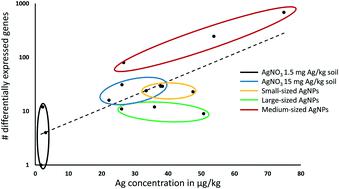当前位置:
X-MOL 学术
›
Environ. Sci.: Nano
›
论文详情
Our official English website, www.x-mol.net, welcomes your feedback! (Note: you will need to create a separate account there.)
Surface coating and particle size are main factors explaining the transcriptome-wide responses of the earthworm Lumbricus rubellus to silver nanoparticles
Environmental Science: Nano ( IF 7.3 ) Pub Date : 2020-02-19 , DOI: 10.1039/c9en01144g Dick Roelofs 1, 2, 3, 4, 5 , Sunday Makama 5, 6, 7, 8 , Tjalf E. de Boer 5, 9, 10 , Riet Vooijs 1, 2, 3, 4, 5 , Cornelis A. M. van Gestel 1, 2, 3, 4, 5 , Nico W. van den Brink 5, 6, 7, 8
Environmental Science: Nano ( IF 7.3 ) Pub Date : 2020-02-19 , DOI: 10.1039/c9en01144g Dick Roelofs 1, 2, 3, 4, 5 , Sunday Makama 5, 6, 7, 8 , Tjalf E. de Boer 5, 9, 10 , Riet Vooijs 1, 2, 3, 4, 5 , Cornelis A. M. van Gestel 1, 2, 3, 4, 5 , Nico W. van den Brink 5, 6, 7, 8
Affiliation

|
Due to the unique properties of differently sized and coated silver nanoparticles (AgNPs), they are used in important industrial and biomedical applications. However, their environmental fate in soil ecosystems and potential mechanisms of toxicity remain elusive, especially at the level of transcriptional regulation. We investigated the transcriptome-wide responses of the earthworm Lumbricus rubellus exposed to nine AgNPs differing in surface coating/charge (bovine serum albumin/negative AgNP_BSA, chitosan/positive AgNP_Chit, and polyvinylpyrrolidone/neutral AgNP_PVP) and sizes (20, 35 and 50 nm) at concentrations close to the EC50 value related to reproduction. AgNO3 was used in two concentrations to benchmark the AgNP effects against those of the Ag salt. A correlation was observed between the number of differentially expressed genes (DEGs) and Ag internal body concentration. Only metallothionein was regulated by all treatments. Medium sized AgNPs caused the most pronounced transcriptional responses, while AgNO3 affected the transcriptome less. Medium sized AgNP_BSA exposure caused the most extensive transcriptional responses with 684 DEGs. Gene ontology enrichment analysis of medium sized AgNP_BSA affected DEGs revealed that mitochondrial electron transport, autophagy and phagocytosis, mesoderm and heart development and microtubule organisation were affected. This was also confirmed by gene set enrichment for KEGG pathway analysis, indicating that phagocytosis, autophagy and signalling pathways related to mesoderm formation were significantly up regulated. All AgNP_BSA and AgNP_PVP exposures caused severe down regulation of ribosomal translation, suggesting that the high energy-demanding protein synthesis process is inhibited. Our data confirm the mechanisms previously identified among other animal models and human cell lines. To conclude, coating formulation and particle size severely impact transcriptional responses at a particular nanoparticle size, suggesting diverse mechanistic responses depending on the coating type.
中文翻译:

表面涂层和粒径是解释wormLumbricus rubellus对银纳米粒子的转录组范围响应的主要因素
由于不同大小和涂层的银纳米颗粒(AgNP)的独特性能,它们被用于重要的工业和生物医学应用中。但是,它们在土壤生态系统中的环境命运和潜在的毒性机制仍然难以捉摸,尤其是在转录调控方面。我们研究的蚯蚓的全转录物反应地龙rubellus的暴露于9周的AgNPs在表面涂层不同/电荷(牛血清白蛋白/负AgNP_BSA,脱乙酰壳多糖/正AgNP_Chit,和聚乙烯基吡咯烷酮/中性AgNP_PVP)和尺寸(20,35和50纳米)浓度接近与繁殖有关的EC 50值。AgNO 3用两种浓度的AgO2来比较AgNP对Ag盐的影响。差异表达基因(DEG)的数量与体内Ag浓度之间存在相关性。所有处理仅调节金属硫蛋白。中型AgNP引起最明显的转录反应,而AgNO 3对转录组的影响较小。中型AgNP_BSA暴露引起684 DEG的最广泛的转录反应。中型受AgNP_BSA影响的DEG的基因本体富集分析表明,线粒体电子转运,自噬和吞噬作用,中胚层和心脏发育以及微管组织受到影响。KEGG通路分析的基因集富集也证实了这一点,表明与中胚层形成有关的吞噬作用,自噬和信号通路明显上调。所有AgNP_BSA和AgNP_PVP暴露都会导致核糖体翻译的严重下调,这表明高能量需求的蛋白质合成过程受到抑制。我们的数据证实了先前在其他动物模型和人类细胞系中确定的机制。最后,
更新日期:2020-02-19
中文翻译:

表面涂层和粒径是解释wormLumbricus rubellus对银纳米粒子的转录组范围响应的主要因素
由于不同大小和涂层的银纳米颗粒(AgNP)的独特性能,它们被用于重要的工业和生物医学应用中。但是,它们在土壤生态系统中的环境命运和潜在的毒性机制仍然难以捉摸,尤其是在转录调控方面。我们研究的蚯蚓的全转录物反应地龙rubellus的暴露于9周的AgNPs在表面涂层不同/电荷(牛血清白蛋白/负AgNP_BSA,脱乙酰壳多糖/正AgNP_Chit,和聚乙烯基吡咯烷酮/中性AgNP_PVP)和尺寸(20,35和50纳米)浓度接近与繁殖有关的EC 50值。AgNO 3用两种浓度的AgO2来比较AgNP对Ag盐的影响。差异表达基因(DEG)的数量与体内Ag浓度之间存在相关性。所有处理仅调节金属硫蛋白。中型AgNP引起最明显的转录反应,而AgNO 3对转录组的影响较小。中型AgNP_BSA暴露引起684 DEG的最广泛的转录反应。中型受AgNP_BSA影响的DEG的基因本体富集分析表明,线粒体电子转运,自噬和吞噬作用,中胚层和心脏发育以及微管组织受到影响。KEGG通路分析的基因集富集也证实了这一点,表明与中胚层形成有关的吞噬作用,自噬和信号通路明显上调。所有AgNP_BSA和AgNP_PVP暴露都会导致核糖体翻译的严重下调,这表明高能量需求的蛋白质合成过程受到抑制。我们的数据证实了先前在其他动物模型和人类细胞系中确定的机制。最后,


























 京公网安备 11010802027423号
京公网安备 11010802027423号